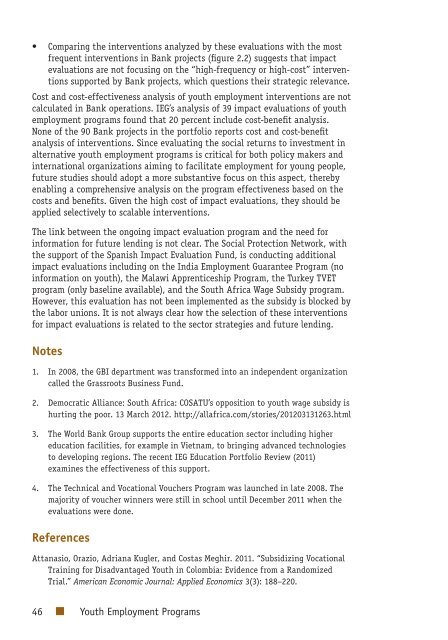Youth Employment Programs - Independent Evaluation Group
Youth Employment Programs - Independent Evaluation Group
Youth Employment Programs - Independent Evaluation Group
You also want an ePaper? Increase the reach of your titles
YUMPU automatically turns print PDFs into web optimized ePapers that Google loves.
• Comparing the interventions analyzed by these evaluations with the mostfrequent interventions in Bank projects (figure 2.2) suggests that impactevaluations are not focusing on the “high-frequency or high-cost” interventionssupported by Bank projects, which questions their strategic relevance.Cost and cost-effectiveness analysis of youth employment interventions are notcalculated in Bank operations. IEG’s analysis of 39 impact evaluations of youthemployment programs found that 20 percent include cost-benefit analysis.None of the 90 Bank projects in the portfolio reports cost and cost-benefitanalysis of interventions. Since evaluating the social returns to investment inalternative youth employment programs is critical for both policy makers andinternational organizations aiming to facilitate employment for young people,future studies should adopt a more substantive focus on this aspect, therebyenabling a comprehensive analysis on the program effectiveness based on thecosts and benefits. Given the high cost of impact evaluations, they should beapplied selectively to scalable interventions.The link between the ongoing impact evaluation program and the need forinformation for future lending is not clear. The Social Protection Network, withthe support of the Spanish Impact <strong>Evaluation</strong> Fund, is conducting additionalimpact evaluations including on the India <strong>Employment</strong> Guarantee Program (noinformation on youth), the Malawi Apprenticeship Program, the Turkey TVETprogram (only baseline available), and the South Africa Wage Subsidy program.However, this evaluation has not been implemented as the subsidy is blocked bythe labor unions. It is not always clear how the selection of these interventionsfor impact evaluations is related to the sector strategies and future lending.Notes1. In 2008, the GBI department was transformed into an independent organizationcalled the Grassroots Business Fund.2. Democratic Alliance: South Africa: COSATU’s opposition to youth wage subsidy ishurting the poor. 13 March 2012. http://allafrica.com/stories/201203131263.html3. The World Bank <strong>Group</strong> supports the entire education sector including highereducation facilities, for example in Vietnam, to bringing advanced technologiesto developing regions. The recent IEG Education Portfolio Review (2011)examines the effectiveness of this support.4. The Technical and Vocational Vouchers Program was launched in late 2008. Themajority of voucher winners were still in school until December 2011 when theevaluations were done.ReferencesAttanasio, Orazio, Adriana Kugler, and Costas Meghir. 2011. “Subsidizing VocationalTraining for Disadvantaged <strong>Youth</strong> in Colombia: Evidence from a RandomizedTrial.” American Economic Journal: Applied Economics 3(3): 188–220.46 <strong>Youth</strong> <strong>Employment</strong> <strong>Programs</strong>
















